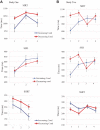Monetary rewards modulate inhibitory control
- PMID: 24860469
- PMCID: PMC4026705
- DOI: 10.3389/fnhum.2014.00257
Monetary rewards modulate inhibitory control
Abstract
The ability to override a dominant response, often referred to as behavioral inhibition, is considered a key element of executive cognition. Poor behavioral inhibition is a defining characteristic of several neurological and psychiatric populations. Recently, there has been increasing interest in the motivational dimension of behavioral inhibition, with some experiments incorporating emotional contingencies in classical inhibitory paradigms such as the Go/NoGo and Stop Signal Tasks (SSTs). Several studies have reported a positive modulatory effect of reward on performance in pathological conditions such as substance abuse, pathological gambling, and Attention Deficit Hyperactive Disorder (ADHD). However, experiments that directly investigate the modulatory effects of reward magnitudes on the performance of inhibitory tasks are scarce and little is known about the finer grained relationship between motivation and inhibitory control. Here we probed the effect of reward magnitude and context on behavioral inhibition with three modified versions of the widely used SST. The pilot study compared inhibition performance during six blocks alternating neutral feedback, low, medium, and high monetary rewards. Study One compared increasing vs. decreasing rewards, with low, high rewards, and neutral feedback; whilst Study Two compared low and high reward magnitudes alone also in an increasing and decreasing reward design. The reward magnitude effect was not demonstrated in the pilot study, probably due to a learning effect induced by practice in this lengthy task. The reward effect per se was weak but the context (order of reward) was clearly suggested in Study One, and was particularly strongly confirmed in study two. In addition, these findings revealed a "kick start effect" over global performance measures. Specifically, there was a long lasting improvement in performance throughout the task when participants received the highest reward magnitudes at the beginning of the protocol. These results demonstrate a dynamical behavioral inhibition capacity in humans, as illustrated by the reward magnitude modulation and initial reward history effects.
Keywords: behavioral analysis; cognitive control; inhibition (psychology); reward; stop signal task.
Figures



References
-
- Avila C., Parcet M. A. (2001). Personality and inhibitory deficits in the stop-signal task: the mediating role of Gray's anxiety and impulsivity. Pers. Individ. Dif. 31, 975–986 10.1016/S0191-8869(00)00199-9 - DOI
-
- Banaschewski T., Brandeis D., Heinrich H., Albrecht B., Brunner E., Rothenberger A. (2003). Association of Attention Deficit Hyperactive Disorder (ADHD) and conduct disorder–brain electrical evidence for the existence of a distinct subtype. J. Child Psychol. Psychiatry 44, 356–376 10.1111/1469-7610.00127 - DOI - PubMed
Grants and funding
LinkOut - more resources
Full Text Sources
Other Literature Sources

